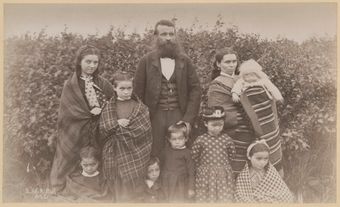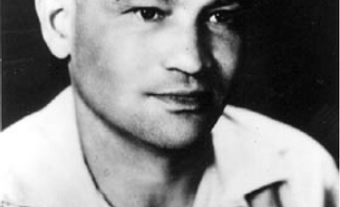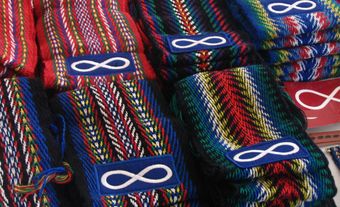Family and Ancestry
Felix Callihoo was one of twelve children (one of whom died at birth) born to Chief Michel Callihoo (1824–1911) and Philomene Collin (1848–1932). Michel Callihoo was the son of Chief Louis Kwarakwante, who was born in 1782 in the Iroquois Village of Caughnawaga, near Montreal, settled near Jasper (Alberta) around 1801 and died in 1846. Chief Callihoo’s mother was Louis’s second wife Marie Patenaude (1803–1854), the Métis daughter of Michel Patenaude and Francoise Crise. Michel Callihoo’s first wife was Marie Savard (1828–69); he subsequently married Philomene Collin.
On 23 September 1878, Chief Michel Callihoo signed Treaty 6 on behalf of his band of Iroquois, Métis, and Cree relatives. The band was granted a reserve of 40 square miles (103.6 square kilometres) northwest of Edmonton on the Sturgeon River. The reserve (“Michel I.R. 132”) was confirmed by Order in Council PC 1151 on 17 May 1889. It became a successful farming community over the next decade. However, the Michel Band was pressured to give up some of the land in return for agricultural provisions (supplies), which had been promised under the Treaty. This loss of land and his father’s work on behalf of land rights may have inspired Felix Callihoo in his political activism.
The Métis Association of Alberta
In 1928, led by Charles Delorme, Métis in the Cold Lake area began organizing in response to the federal government’s decision to transfer control of natural resources to the province. Two years later, on 24 May 1930, a group of Métis met at the Roman Catholic church on the Frog Lake Indian Reserve. Approximately 30 people attended, including Joseph Dion, an enfranchised Indigenous political organizer and teacher who was also a devout Catholic. Joseph Dion, Cree on his mother’s side and Metis on his father’s, would become one of the most influential leaders of the Métis political movement of the 1930s. During the summer of 1931, the Métis in Alberta organized around the idea of a land grant from the provincial government as a possible solution to the socio-economic problems facing Métis communities. As part of this effort, they elected six councillors to represent Métis interests at the provincial level and circulated a petition.
In 1932, Dion wrote to Métis councillors throughout Alberta and asked them to attend a meeting scheduled for 28 December 1932. The main topics on the agenda were: (1) the object and aims of the Métis Association of Alberta; (2) a decision on the most suitable location or locations for the reserves or settlements; and (3) the question of education for Métis children. On 28 December, 33 councillors met in the basement of the Roman Catholic church in St. Albert and formally constituted the Association des Métis d’Alberta et des Territoires du Nord-Ouest (also known as the Métis Association of Alberta or MAA).
At the December 1932 meeting, Felix Callihoo gave a long and passionate speech that blamed failed governmental policies for the current socio-economic conditions faced by the Métis people. He rejected the popular belief, which was based on the “pathology model,” that the Métis people were to blame for their own suffering. As Nicole C. O’Byrne has noted in a 2013 article about the MAA, Callihoo called on the Alberta government to redress historical injustices by developing land, health, education, and natural resource policies for the Métis.
Joseph Dion also gave a speech at the meeting. Yet his vision for MAA was more paternalistic and informed by the pathology model, which framed the status of the Métis as similar to an illness that required state care. Despite ideological differences within the MAA, the primary, shared goal in the early years was to secure a land base for the Métis of Alberta.
At the December 1932 meeting, the MAA was formally established as a self-governing organization with an executive overseeing the 31 locals throughout Alberta. Joseph Dion was voted in as the first president. Malcolm Norris was 1st vice-president, Callihoo was 2nd vice-president and Henry Cunningham was 3rd vice-president (he was replaced by Peter Tomkins in 1934). It appears that Callihoo’s brother Johnny (born 1883) married Sophie Cunningham (1882–1942), possibly a relative of Henry. Jim Brady became Secretary-Treasurer. The ideological differences revealed in the 1932 speeches given by Callihoo and Dion eventually led to problems in the organization. Although Callihoo was clearly an important voice in 1932, it seems that he became less prominent in the organization in later years.

The First Métis Association of Alberta (MAA) Executive. Back Row L-R: Peter Tomkins (vice-president), Felix Callihoo (vice-president); Front Row L-R: Malcolm Norris (vice-president), Joseph Dion (president), James Brady (secretary-treasurer). Courtesy Glenbow Archives PA-2218-109.
The Ewing Commission
In 1934, in response to lobbying by the Métis Association of Alberta (MAA), the Alberta government appointed the Royal Ewing Commission to examine and report on Métis health, education, homelessness and land issues. Judge Albert F. Ewing was appointed chair. Joseph Dion, Malcolm Norris and Adrian Hope consistently attended the Commission’s hearings on behalf of the MAA. It is not known if Callihoo was also a regular attendee, but it seems that his role in the MAA may have diminished during this period. Nonetheless, along with other MAA leaders Dion, Norris, Jim Brady and Peter Tomkins, Callihoo was part of the group known as the “Big Five.” Less is known about Callihoo than some of the other members of the MAA, but it is possible to speculate that, like his fellow activists, Callihoo experienced racism throughout his life as a Métis individual. At least one source has referred to the “Big Four” as being comprised of Dion, Norris, Brady and Tomkins. This suggests that during and following the Ewing Commission’s investigation, Callihoo either left the MAA or played a smaller role.
After a two-year investigation, the Ewing Commission recommended that the province provide the Métis of Alberta with a secure land base and adequate services; this is also referred to as the establishment of Métis settlements. According to O’Byrne (2013), this was the first and only time a provincial government granted land based on Métis claims. O’Byrne argues that the MAA lobbied for the land grants because they were motivated by a desire to redress historical injustices against the Métis, while the provincial government saw the settlements as merely an expedient way to provide socio-economic relief to Métis communities.
The Ewing Commission led to the 1938 Metis Population Betterment Act. This created the province’s twelve original Métis “colonies” (also known as Métis Settlements). Since then, four have been dissolved. Nonetheless, it is important to remember that the Ewing Commission did not view the Métis people as full partners, or even as sovereign adult human subjects. For instance, in correspondence between the commission’s secretary, T.C. Rankine, and the Deputy Minister of Lands and Mines, J.M. Harvie, it was stated that “It is perfectly true that these people are like children, helpless and irresponsible.” Furthermore, the Métis did not directly benefit from natural resources such as fish, fur and timber that were viewed as the possessions of the Canadian government. For these and other reasons, the MAA, and now the Métis Nation of Alberta, continues to fight for Métis rights, sovereignty and equality.
Archives
In his book The Alberta Métis Letters: 1930–1940 Policy Review and Annotations (2008), Denis Wall states that Callihoo was elected to the executive of the Association des Métis d’Alberta et des Territoires du Nord-Ouest (Métis Association of Alberta) in December 1932. According to Wall’s research, there are two letters written by Callihoo between 1930 and 1940 in the Glenbow Museum’s archives in Calgary. The Glenbow also has a file of letters written by Callihoo in the 1940s. Based on the archives, Jim Brady may have been in frequent (or daily) contact with Callihoo in late 1933.
Legacy
Felix Callihoo was an important Métis leader, particularly in the 1930s. He played a major role in the creation of the Métis Association of Alberta (MAA) between 1928 and 1932. He also played a pivotal role in Métis affairs during the Great Depression, ensuring that his people gained a more secure land base and improved socio-economic conditions in difficult economic times.

 Share on Facebook
Share on Facebook Share on X
Share on X Share by Email
Share by Email Share on Google Classroom
Share on Google Classroom










